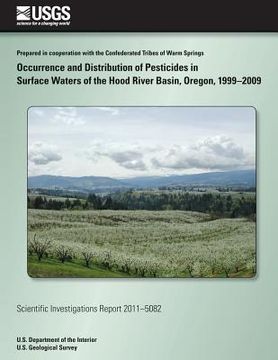Compartir
Occurrence and Distribution of Pesticides in Surface Waters of the Hood River Basin, Oregon, 1999-2009 (en Inglés)
Henry M. Johnson
(Autor)
·
Whitney B. Temple
(Autor)
·
Createspace Independent Publishing Platform
· Tapa Blanda
Occurrence and Distribution of Pesticides in Surface Waters of the Hood River Basin, Oregon, 1999-2009 (en Inglés) - Johnson, Henry M. ; Temple, Whitney B.
$ 86.724
$ 173.449
Ahorras: $ 86.724
Elige la lista en la que quieres agregar tu producto o crea una nueva lista
✓ Producto agregado correctamente a la lista de deseos.
Ir a Mis Listas
Origen: Estados Unidos
(Costos de importación incluídos en el precio)
Se enviará desde nuestra bodega entre el
Martes 23 de Julio y el
Martes 06 de Agosto.
Lo recibirás en cualquier lugar de Colombia entre 1 y 5 días hábiles luego del envío.
Reseña del libro "Occurrence and Distribution of Pesticides in Surface Waters of the Hood River Basin, Oregon, 1999-2009 (en Inglés)"
unknown. Trace-element concentration data, although limited, indicate that eight trace elements are also of concern for their potential to harm salmonid health. The dataset is limited with regard to the spatial and seasonal distribution of pesticides and trace elements in all salmonid-bearing streams, the presence of particle-bound pesticides, and the presence of several unmonitored pesticides known to be used in the basin. Introduction Hood River drains 339 mi2 on the northern side of Mt. Hood in Oregon and joins the Columbia River at the city of Hood River (fig. 1). Annual precipitation varies with topography, exceeding 110 in. in the southern, high elevation areas near Mt. Hood and averaging 30 in. on the valley floor near the city of Hood River. Most of the Hood River basin is forested and much of the remaining land is in agriculture (appendix A). Hood River is the largest city in the basin and has a population of 6,945 (U.S. Census Bureau, 2010). Agriculture, forest products, and tourism provide the economic base of the area. Historically, the Hood River and its tributaries served as important spawning and rearing streams for anadromous and nonmigratory salmonids and for Pacific lamprey. Currently, three salmonids native to the Hood River basin are listed as "threatened" by the U.S. Fish and Wildlife Service (2010) under the U.S. Endangered Species Act-bull trout, steelhead, and Chinook salmon-in response to declining populations. The Pacific lamprey is a culturally significant fish for the native tribes along the Columbia River. As recently as 1963, Pacific lamprey were found throughout the basin (U.S. Department of Agriculture Forest Service, 1996). Their population has been limited to the lower 4.5 miles of Hood River since at least the mid-1990s. Three hundred seventy- three miles of streams in the Hood River basin are classified as critical habitat for salmonids (StreamNet, 2010). Instream passage barriers, flow modification, impaired water quality, and natural and anthropogenically induced sedimentation have been identified as contributors to the declining populations (Coccoli, 2004). The U.S. Geological Survey analyzed pesticide and trace-element concentration data from the Hood River basin collected by the Oregon Department of Environmental Quality (ODEQ) from 1999 through 2009 to determine the distribution and concentrations of pesticides in the basin's surface waters. Instream concentrations were compared to (1) national and State water-quality standards established to protect aquatic organisms and (2) concentrations that cause sublethal or lethal effects in order to assess their potential to adversely affect the health of salmonids and their prey organisms. Three salmonid species native to the basin are listed as "threatened" under the U.S. Endangered Species Act: bull trout, steelhead, and Chinook salmon.

